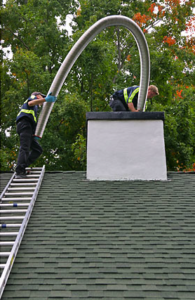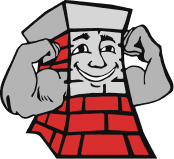What is Chimney Relining, and is it Necessary?
 All chimneys today are supposed to be lined, either with clay tile, a cast-in-place flue, or a metal liner, by dictate of building codes. Perhaps with the exception of stainless steel liners, all of these flue liners eventually deteriorate and fail to function the way they are supposed to. A sound chimney liner is essential to the safe utilization of fireplaces and other wood-burning appliances.
All chimneys today are supposed to be lined, either with clay tile, a cast-in-place flue, or a metal liner, by dictate of building codes. Perhaps with the exception of stainless steel liners, all of these flue liners eventually deteriorate and fail to function the way they are supposed to. A sound chimney liner is essential to the safe utilization of fireplaces and other wood-burning appliances.
There are three primary functions of chimney liners:
1. A chimney liner prevents the transfer of heat to combustible components of a building which surround the chimney. One test showed that the heat in an unlined chimney caused the adjacent woodwork in a home to catch fire in just 3 ½ hours. Even one small crack in the liner can cause a house fire.
2. The gases created by burning combustible materials in the fireplace are acidic and can literally destroy the mortar in a chimney. As the mortar joints erode, the heat from the chimney is able to transfer to combustibles nearby and cause a fire. In addition, the eroded mortar can result in dangerous gases, including carbon monoxide, leaking into the home.
3. When an appliance such as a wood stove or gas furnace is installed, the flue in the chimney must be the proper size for the appliance. If the liner is the wrong size, the potential results include excessive buildup of creosote and the production of deadly, odorless carbon monoxide. Oftentimes, a flue liner in the chimney is needed in order to fit an appliance.
When you get your chimney inspected, the chimney professional could discover that your current liner needs to be replaced, which calls for chimney relining.
Metal
Metal liners are usually constructed of stainless steel or aluminum. Stainless steel liners are preferred by installers and recommended by fire-protection experts. The most costly type of liner, stainless steel flues are suitable for all applications, including gas, wood burning, and oil. Aluminum is inexpensive but only appropriate for certain medium efficiency gas appliances.
Cast-in-Place
Cast-in-place flue liners are created by pouring a cement-like product along the outer walls of the chimney passageway. This relining option provides a well-insulated flue which can also help to improve the chimney’s structural integrity. Cast-in-place flue liners help fireplaces to burn cleaner, which means there is less of an accumulation of creosote.
Installing a cast-in-place flue liner requires the tools and experience of professionals; it is not a do-it-yourself type of job.
Clay Tile
Clay tile flues are the traditional favorite in new homes. If installed properly, the service life of a clay tile flue can easily exceed five decades. Essentially the only maintenance required is regular cleaning. Flue tiles have the capability of withstanding the heat and deposits of corrosive byproducts when burning any and all types of fuel.
Replacing clay tile flues is much more difficult than building a chimney with a clay tile liner. But when the mortar joints between the tiles or the tiles themselves begin to deteriorate, a new liner is needed. Although the tiles are inexpensive, relining a chimney with clay tiles is costly because of the installation labor.

Let a professional chimney sweep replace your liner to keep your chimney safe and functional.
Relining a chimney with clay tile is, in fact, extremely labor intensive. It’s usually necessary to break through the chimney walls every few vertical feet in order to remove old flue tiles and install new ones.
It’s never welcome news when expensive repairs are needed, but there is an upside to
relining a chimney. Once your flue is sound, you can burn your fireplace or wood stove with assurance that your home and family is safe from the threat of a house fire and the leaking of dangerous gases. Contact our professionals for more information about chimney relining and for all of your chimney and venting needs.
Northeastern Chimney, Inc
37 Cody Street, West Hartford, CT 06110
Phone: 860-233-5770


